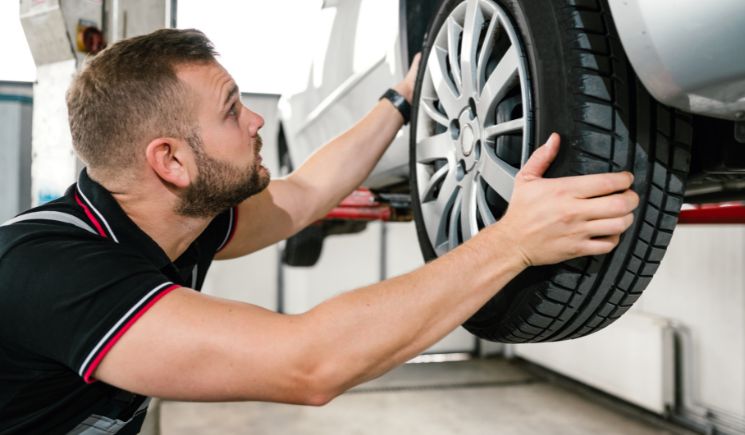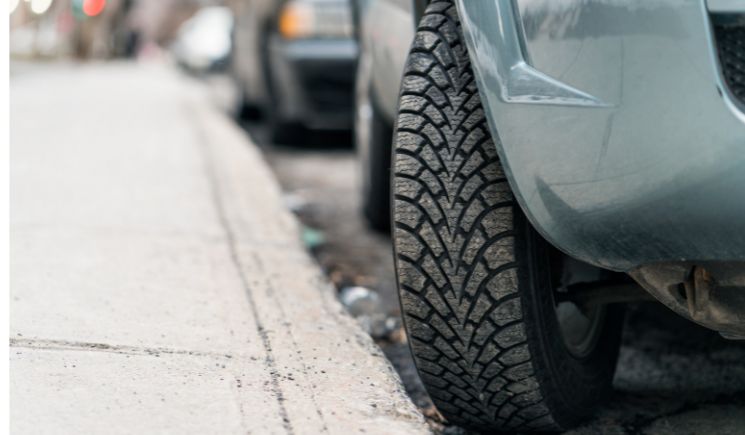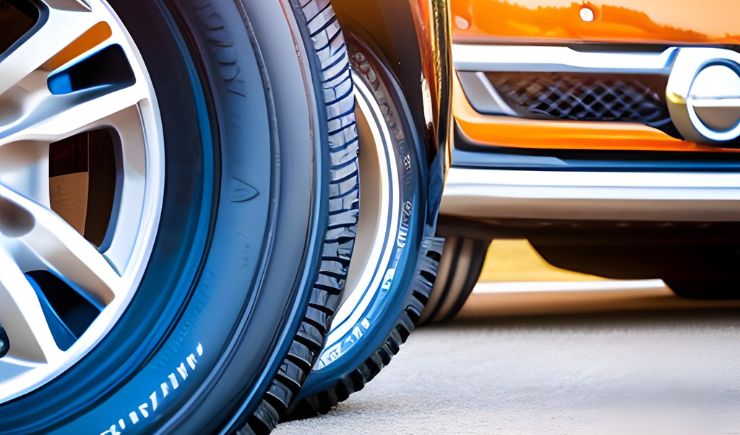Tires Feel Like They Are Dragging When Turning

Tire drag is a common issue for many drivers. It can cause vehicles to feel sluggish and slow, creating an unpleasant driving experience.
As an automotive tire specialist, I understand the importance of keeping your tires in good condition. In this article, I will explore why tires may feel like they are dragging when turning, as well as potential solutions that you can use to fix the problem.
Stay tuned to find out more!
Table of Contents
- Diagnosing The Problem
- Tire Alignment Issues
- Tire Wear And Tear
- Problems With The Suspension
- Other Potential Causes
- Frequently Asked Questions
- Conclusion
Diagnosing The Problem
Driving can be a drag. Especially when you feel like your car is being held back by something that’s out of your control – like tires dragging on the road. If you are feeling this sensation while turning, it could be a sign that there is an issue with your tires and they need attention from a specialist.
As an automotive tire expert, I know all too well how frustrating these problems can be for drivers.
The first step to diagnosing the problem is to check the air pressure in each tire; if not properly inflated, this will cause them to drag more than usual, reducing overall efficiency and performance.
Another thing to consider is whether or not the tread depth is sufficient; worn-out tires require extra effort to grip the road as effectively as newer ones do, creating additional resistance during turns.
If neither of those checks reveal any issues, then it may be time to look at other potential causes such as tire alignment issues…
Tire Alignment Issues

Once the cause of the dragging tires had been determined, it was time to investigate tire alignment issues. Tire alignment is a complex process that requires precise measurements and adjustments for optimal performance. A misalignment can cause premature wear on your tires which will result in reduced handling capabilities:
- Toe – The angle between a vehicle’s wheels when viewed from above; this should be parallel or nearly so for optimal performance
- Camber – How much a wheel tilts inward or outward at the top when viewed from the front; this should remain close to zero camber setting
- Caster – This refers to how far forward or backward slanted the steering axis is relative to vertical; positive caster gives better stability while negative caster causes instability and decreased road feel as well as excessive vibration
As an automotive tire specialist, I have seen many vehicles with improper toe settings leading to under-inflated tires due to uneven contact patch pressure distribution across the tread resulting in poor fuel economy and increased rolling resistance.
With proper care and maintenance, however, these problems are easily rectified through realigning your tires according to manufacturer specifications. For maximum performance and safety, regular checks on tire pressures and alignment angles must be done periodically throughout its life span.
Having checked all possible sources of drag, we turn our attention next towards understanding tire wear and tear.
Tire Wear And Tear
As an automotive tire specialist, I have seen numerous cases of tires dragging while turning. In many instances, the cause is excessive wear and tear on the tires due to inadequate maintenance or other factors. To better illustrate this problem, I’ve included a chart below which shows different types of tire damage that can lead to poor performance when turning:
| Type of Damage | Symptoms | Causes |
|---|---|---|
| Worn Treads | Reduced traction & uneven braking/acceleration | Overinflation, under-rotation, improper alignment |
| Flat Spotting | Vibrations during acceleration/braking | Driving too fast over potholes or curbs, parking for extended periods in one spot |
| Bulging Sidewalls | Drifting when turning | High speed cornering, hitting obstacles at high speeds |
It’s clear from these examples that worn treads, flat spotting, bulging sidewalls and cracked sides are all common causes of dragged tires when turning. If any of these issues are present then it may be time for new set of tires as continuing with worn tires will result in further problems down the line.
It’s also important to pay attention to proper maintenance techniques such as regular rotation and proper inflation levels so as to avoid premature wear and tear on your tires. With all that said, let us now move onto exploring potential problems with suspension systems which could also be causing drag while turning.
Problems With The Suspension
Tire wear and tear is an important factor to consider when assessing the condition of your vehicle. Worn tires can cause a number of issues, including increased resistance while turning.
This can be caused by excessive tread wear on one side or due to other factors such as misalignment. It’s important to have your tires checked regularly to ensure they are in good condition before any problems arise.
If it appears that there may be more serious problems affecting the suspension, then further investigation must take place. Problems with the suspension can result in a lack of control over steering movements and could lead to dangerous driving conditions if left unchecked.
These issues may include worn shocks, loose ball joints, or uneven tire pressure which often require professional repair services.
It is also worth noting that these symptoms could be caused by other potential causes unrelated to the tires or suspension system. Therefore, it is essential that you get your vehicle inspected thoroughly so any underlying issues can be identified and addressed quickly and effectively.
Other Potential Causes
When it comes to tires feeling like they are dragging when turning, there are a few other potential causes that should be considered.
It could be an alignment issue, in which the wheel’s angles and position may not be properly set up for optimal performance. If this is the case, then realignment services can help increase tire life expectancy and improve traction as well.
Another potential cause of Tires feeling sluggish when turning is worn suspension components such as ball joints or tie rod ends. These parts often wear out over time due to normal use, resulting in decreased steering control and increased friction between the tires and road surface. Replacing these components will restore handling to its original state and provide better overall driving feel.
Lastly, another possible explanation behind why your car feels like it’s being dragged around when you turn is misaligned brakes. Brake calipers need to be properly adjusted in order for them to function correctly; otherwise, you’ll experience reduced stopping power along with excessive drag from the wheels while cornering. A simple service appointment at your local repair shop should take care of this problem quickly and efficiently.
No matter what might be causing your car’s tires to drag when turning, identifying the root of the issue is key to getting back on the road safely and securely again soon!
Frequently Asked Questions
What Type Of Tires Should I Use For My Vehicle?
Choosing the right tires for your vehicle is essential to ensure a safe and comfortable driving experience.
When selecting the perfect set of tires, you’ll need to consider factors such as size, speed rating, load capacity, terrain type and price point.
You should also take into account any existing conditions like if your Tires not responding smoothly in turns.
By taking these considerations into account and consulting a tire specialist, you can be sure to find the ideal set of tires for your vehicle’s needs.
How Often Should I Rotate My Tires?
Rotating your tires is an important part of maintaining their health and ensuring they’re in proper working order.
Generally, you should rotate them every 5,000 to 8,000 miles or at least twice a year.
This will help ensure even wear and tear on the treads so that their lifespan remains optimal.
Additionally, having a professional mechanic check tire alignment and pressure can further extend their life by preventing premature wearing.
How Much Does A Tire Alignment Cost?
A tire alignment can cost anywhere from $50 to several hundred dollars, depending on the make and model of your vehicle. The type of service you need will also be a factor in determining the price.
Generally speaking, though, most people should expect to pay somewhere between $90-$150 for a basic front-end alignment.
It’s important to get an alignment done regularly as part of regular car maintenance – it’ll help extend the life of your tires and improve its overall performance.
What Is The Best Way To Check For Tire Wear And Tear?
When it comes to checking for tire wear and tear, there are a few key indicators that you should be aware of.
Visual inspection is the best way to start; look out for any signs of cracking on the sidewall, or if the tread depth has worn down significantly.
It’s also important to check your air pressure regularly – underinflated tires will wear unevenly and quicker than usual.
Regular rotations can help prolong your tire life too!
Are There Any Signs That Indicate I Need To Replace My Suspension System?
When it comes to your suspension system, there are several signs that could indicate you need to replace it.
If you’re experiencing an uncomfortable ride, uneven tire wear or a bouncing sensation when going over bumps, then these are all possible indicators of worn out suspension components.
Additionally, if your vehicle is drifting in one direction when driving on the highway or steering feels sluggish and unresponsive, this could also be due to faulty suspension parts.
It’s best to have a professional take a look at your car as soon as any of these symptoms start appearing!
Conclusion
When it comes to tires, there is no room for error! It’s essential that you take the proper steps to ensure your vehicle runs safely and efficiently.
I cannot stress enough how important it is to check your tire pressure regularly and rotate them at least every 6 months. Also, a tire alignment should be done annually in order to avoid any uneven wear or drag when turning.
When my clients come into the shop with complaints of a dragging feeling while they turn, I know it’s time for a suspension system upgrade right away. Let me tell you – nothing compares to having brand new tires on your car that make turns feel effortless!
So don’t wait until it’s too late – get those tires checked out today!






